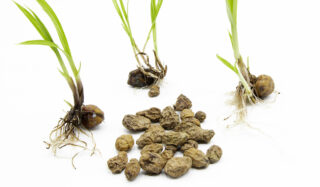Easy to grow, tiger nuts were once a prehistoric human food source and later a tasty snack for ancient Egyptians. Heralded as a superfood by some and an invasive weed by others, this identity crisis seems fitting because tiger nuts aren’t nuts! Named for its coating of distinctive stripes, the tiny root tuber, characteristic of the chufa or yellow nutsedge plant, is chewy and tastes similar to a hazelnut or almond.
High in fiber, magnesium, phosphorus, potassium, and vitamins C and E, its antioxidant powers reduce cellular decay, regulate blood pressure, and help establish a healthy digestive tract. There’s little medical evidence to solidify these claims, but that doesn’t matter. Tiger nuts are vegan and gluten-free, making them a food of note in the 21st-century era of climate change.
Spreading Goodness
Yellow nutsedge and chufa are interchangeable terms, albeit different plants from different places. Both produce tiger nuts and spread via rhizomes that sprout, forming new plants with intact root systems.

Identifiable by a triangular-thin stalk and grass blades spreading out from a 120-degree angle, yellow nutsedge (cyperus esculentus) is a perennial native to North America. It propagates by seed, rhizome, and sprouting tubers (like a potato).
It has become so prevalent in Canada that the Ontario and Manitoba governments have designated it an invasive species. Several US states have done the same. Its tubers, sometimes 35cm underground, protect the plant from surface frosts and freezes, and its resistance to herbicides makes it challenging to eradicate.
Chufa, (Cyperus esculentus var. sativus) is native to Mediterranean regions, Eurasia and North Africa. It is not cold-hardy and rarely sets seeds. Also spread by rhizomes, its tubers cluster closer to the surface and stay concentrated under the plant. It is the source of the majority of commercialized tiger nuts.
Growing At Home
Because many communities use toxic herbicides to eradicate wild yellow nutsedge, unless 100% confident the area hasn’t been sprayed, foraging for the treats may not be wise.
Growing tiger nuts at home in a large and deep container is possible and makes for a unique conversational addition to the veggie patch! That is if you can find seeds. Many areas have banned the sale of tiger nut seeds and plants because of their invasive properties.
Domesticated chufa tubers meant for growing are easier to find. Before planting, soak the tuber in warm water until plump. Remember to change the water often so that it doesn’t ferment.
Plant 5cm deep with each tuber between 7-10cm apart in a porous potting soil and well-draining container. Place outside in a warm sunny spot, and during the growing season, keep the plants well-watered. It is that easy!
In late summer, harvest the tiger nuts by digging up the plant or dumping out the contents of the container and picking off the nutlets. Enjoy fresh or dry and preserve for the winter months.
Sustainability
The actual value of tiger nuts may not be what they bring to the home garden but their versatility. There’s nothing they can’t do. Some studies even suggest using the tuber’s high oil content for biofuel.

In China, chufa is grown as a possible replacement for soybean oil. In West Africa, large organic farms produce tiger nut products, including flour and cooking oil. While in North America, the yellow nutsedge plant is used as a food source for livestock.
Wild and cultivated tiger nuts have proven their adaptability to varying conditions and purposes for millennia. In the era of climate change, this matters not only for a plant’s survival but also for humankind, making them a 21st-century power player.